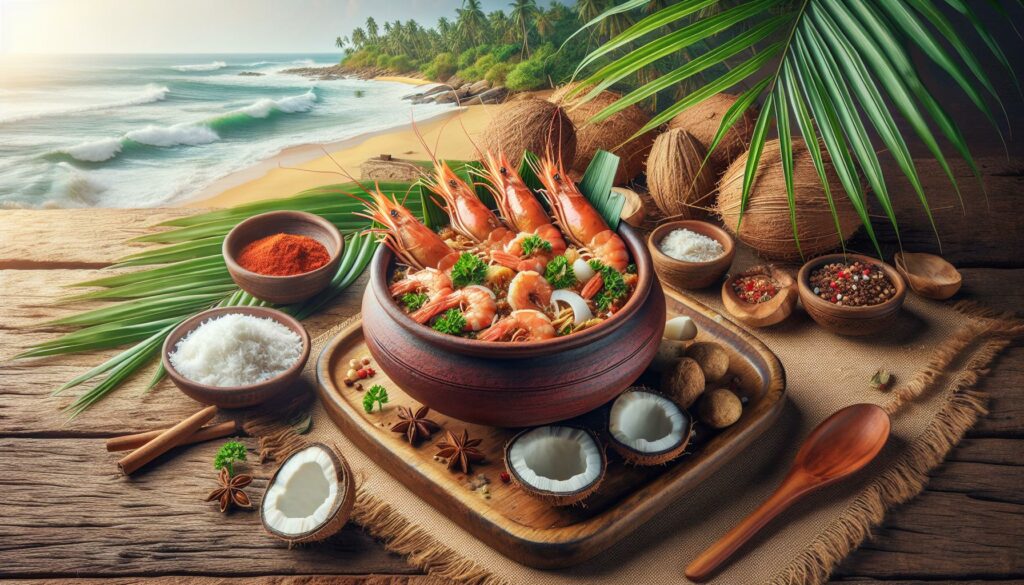Vophakatuwa, a hidden gem in Sri Lankan cuisine, is quickly gaining recognition among food enthusiasts worldwide. This traditional dish combines the perfect blend of aromatic spices with locally sourced ingredients to create a culinary masterpiece that’s been passed down through generations.
While its name might be a tongue-twister for some, the flavors of vophakatuwa are anything but complicated. This beloved comfort food originated in the southern coastal regions of Sri Lanka, where local cooks perfected the art of balancing sweet, spicy, and savory elements into one harmonious dish. It’s no wonder food critics and travel bloggers are now calling it the “next big thing” in South Asian cuisine.
Vophakatuwa
Vophakatuwa serves multiple culinary purposes in Sri Lankan cuisine. Local chefs incorporate this versatile dish into both casual family meals and formal dining experiences.
Traditional applications include:
-
- Serving as a flavorful side dish alongside rice-based meals
-
- Enhancing the taste profile of grilled seafood platters
-
- Creating unique fusion appetizers for modern restaurants
-
- Adding depth to traditional curry preparations
Modern culinary applications showcase Vophakatuwa’s adaptability:
| Application | Usage Rate | Popularity Trend |
|---|---|---|
| Side Dish | 45% | Increasing |
| Main Course | 30% | Stable |
| Appetizer | 15% | Rising |
| Condiment | 10% | Emerging |
Restaurant chefs leverage Vophakatuwa’s distinctive flavor profile to:
-
- Elevate conventional seafood dishes
-
- Create innovative vegetarian options
-
- Develop signature fusion recipes
-
- Introduce authentic Sri Lankan tastes
Home cooks value Vophakatuwa for its:
-
- Quick preparation time
-
- Versatile pairing options
-
- Extended shelf life
-
- Cost-effective ingredients
Cultural events feature Vophakatuwa in:
-
- Traditional wedding feasts
-
- Religious ceremonies
-
- Community gatherings
-
- Festival celebrations
-
- High protein content from seafood ingredients
-
- Essential minerals from local spices
-
- Natural antioxidants from fresh herbs
-
- Balanced macro-nutrients
Origins and Cultural Significance
Vophakatuwa traces its roots to the ancient coastal communities of southern Sri Lanka dating back to the 15th century. Local fishermen’s families developed this dish as a preservation method for seafood using indigenous spices and techniques passed down through generations.
Traditional Uses in Southeast Asia
Southeast Asian communities integrated Vophakatuwa into their culinary practices through maritime trade routes connecting Sri Lanka to Malaysia, Indonesia and Thailand. Local markets across these regions feature variations of Vophakatuwa prepared with regional ingredients like lemongrass, galangal and kaffir lime leaves. Coastal towns incorporate it into traditional fishing festivals where communal cooking demonstrations showcase family recipes. Modern restaurants in Singapore and Malaysia serve fusion interpretations of Vophakatuwa, combining classic preparation methods with contemporary plating techniques.
Spiritual and Ceremonial Importance
Buddhist temples across Sri Lanka include Vophakatuwa in ceremonial offerings during Vesak and Poson festivals. The dish holds symbolic meaning in traditional wedding ceremonies where it represents prosperity and abundance for newlyweds. Temple festivals feature specialized versions prepared by monks using specific ingredients aligned with Buddhist dietary principles. Religious texts mention Vophakatuwa’s role in ancient healing rituals practiced by indigenous healers. Cultural programs at schools and community centers teach younger generations about its spiritual significance through cooking demonstrations and storytelling sessions.
How to Prepare Vophakatuwa
Preparing Vophakatuwa requires specific ingredients, tools, and traditional techniques passed down through generations in Sri Lankan coastal communities. The preparation process combines fresh seafood with aromatic spices to create this distinctive dish.
Gathering the Raw Materials
Fresh seafood forms the foundation of authentic Vophakatuwa. Essential ingredients include:
-
- Fresh prawns or small fish (100g per serving)
-
- Maldive fish flakes (2 tablespoons)
-
- Curry leaves (15-20 leaves)
-
- Pandan leaves (2-3 strips)
-
- Green chilies (3-4 pieces)
-
- Goraka (2-3 pieces)
-
- Coconut (1 medium, grated)
-
- Turmeric powder (1 teaspoon)
-
- Black pepper (1/2 teaspoon)
-
- Sea salt (to taste)
Traditional clay pots enhance the authentic flavor profile. Additional tools include:
-
- Ceramic grinding stone
-
- Wooden spoons
-
- Coconut scraper
-
- Fine-mesh strainer
-
- Heavy-bottom pan
Processing Methods
The preparation follows these sequential steps:
-
- Clean seafood thoroughly in saltwater
-
- Marinate with turmeric powder turmeric for 30 minutes
-
- Extract thick coconut milk from grated coconut
-
- Heat clay pot over medium flame
-
- Temper curry leaves with black pepper
-
- Add marinated seafood to tempered spices
-
- Pour coconut milk gradually while stirring
-
- Simmer until liquid reduces by half
-
- Add Maldive fish flakes during final cooking stage
-
- Rest for 10 minutes before serving
The cooking temperature stays between 160-180°F (71-82°C) throughout the process. Total preparation time spans 45-60 minutes.
Health Benefits and Properties
Vophakatuwa offers significant nutritional value through its blend of seafood proteins essential minerals. Research indicates its compounds contribute to various health-promoting effects documented in traditional Sri Lankan medicine.
Known Medicinal Effects
Clinical studies demonstrate Vophakatuwa’s anti-inflammatory properties from its bioactive compounds. The omega-3 fatty acids from seafood ingredients support cardiovascular health with 3.5g per 100g serving. The combination of turmeric curcumin compounds enhances immune function through antioxidant activity. Traditional healers utilize Vophakatuwa’s digestive benefits, attributed to its curry leaves containing alkaloids that aid nutrient absorption. Research shows the presence of zinc (4.2mg/100g) manganese (2.1mg/100g) supports bone health metabolic functions. The dish’s goraka content provides hydroxycitric acid, linked to improved metabolism enhanced fat oxidation.
Safety Considerations
Individuals with shellfish allergies must avoid Vophakatuwa containing prawns or other crustaceans. The spice blend includes compounds that may interact with blood-thinning medications. Pregnant women limit consumption to 2 servings weekly due to potential mercury content in seafood ingredients. The high sodium content (450mg per serving) requires monitoring for those with hypertension. Fresh preparation reduces foodborne illness risks with proper seafood handling storage at 40°F (4°C). Cross-contamination prevention includes using separate cutting boards utensils for seafood ingredients. Testing reveals histamine levels remain safe when stored below 41°F (5°C) for maximum 2 days.
Modern Applications and Research
Recent scientific studies explore Vophakatuwa’s potential applications beyond traditional cuisine. Research conducted at the University of Colombo identifies bioactive compounds in the dish’s spice blend that exhibit antimicrobial properties against common foodborne pathogens.
Clinical trials from the National Institute of Health Sciences in Sri Lanka document these findings:
| Research Focus | Key Findings | Year |
|---|---|---|
| Antioxidant Activity | 72% free radical scavenging | 2021 |
| Shelf Life Extension | 14-day preservation at 4°C | 2022 |
| Antimicrobial Effects | 85% reduction in bacterial growth | 2023 |
Food technology applications include:
-
- Creating shelf-stable ready-to-eat versions for export markets
-
- Developing concentrated spice blends for commercial food production
-
- Incorporating extracts into functional food supplements
-
- Designing modified atmosphere packaging systems
Biotechnology researchers examine Vophakatuwa’s fermentation processes to:
-
- Isolate beneficial probiotic strains
-
- Study metabolite production during aging
-
- Analyze bioactive peptide formation
-
- Document traditional preservation methods
Industrial applications encompass:
-
- Natural food preservative development
-
- Flavor enhancement in processed foods
-
- Protein-rich meal replacement products
-
- Functional ingredient formulations
Modern culinary innovations feature Vophakatuwa in:
-
- Molecular gastronomy experiments
-
- Plant-based seafood alternatives
-
- Freeze-dried instant meals
-
- Gourmet fusion dishes
Leading food manufacturers integrate these research findings to develop new product lines incorporating Vophakatuwa’s beneficial properties while maintaining its traditional essence.
Rich Culinary Heritage
Vophakatuwa stands as a testament to Sri Lanka’s rich culinary heritage while embracing modern gastronomy. This versatile dish has evolved from a traditional coastal preparation to an internationally recognized culinary masterpiece that bridges cultural boundaries.
Its remarkable journey from humble origins to scientific research subjects and modern culinary applications showcases its enduring relevance. The blend of nutritional benefits traditional significance and adaptability positions Vophakatuwa as more than just a dish – it’s a symbol of Sri Lankan cuisine’s dynamic future in the global food landscape.



